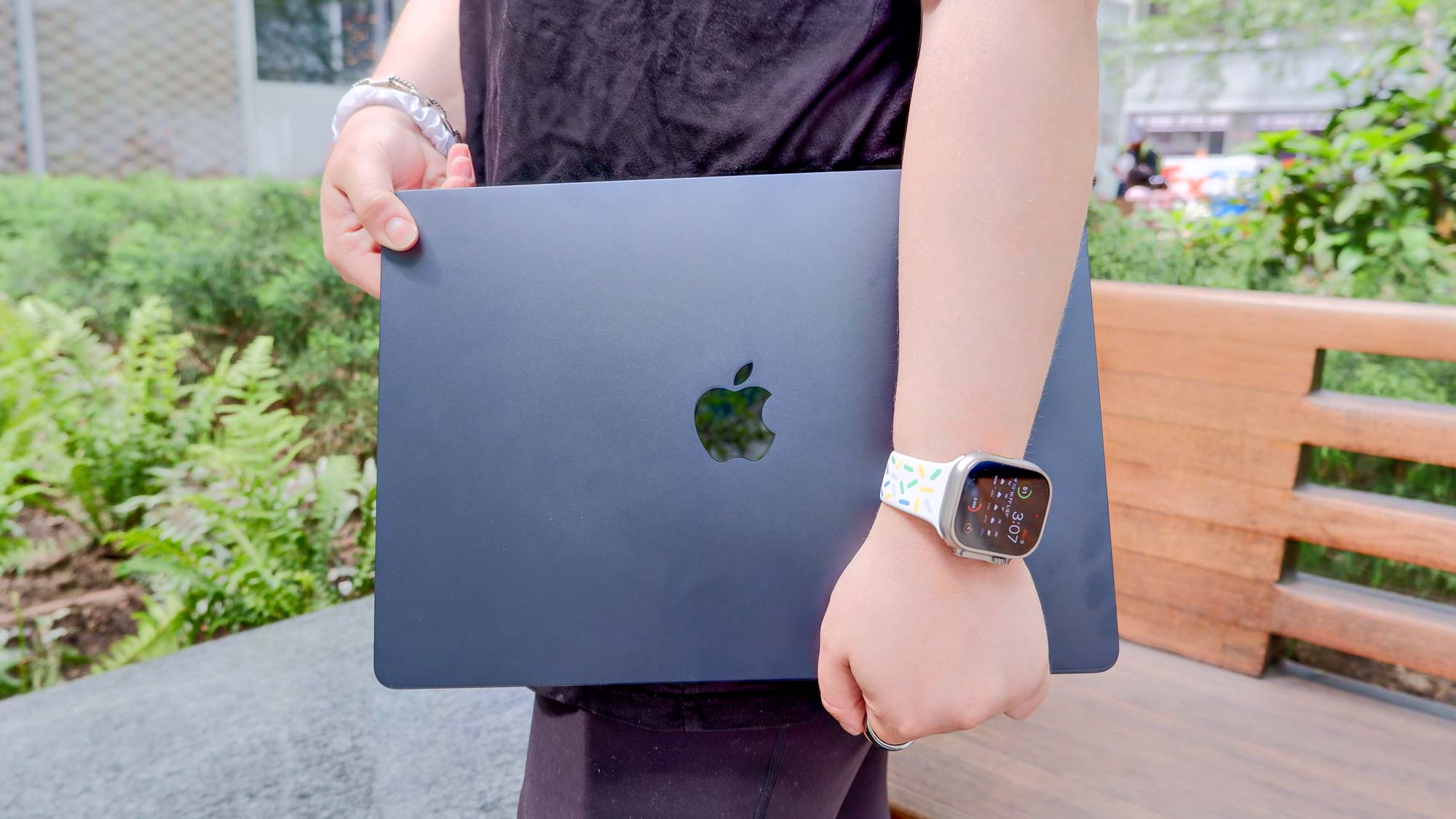Exclusive: How Apple made the 15-inch MacBook Air
How Apple made the world's thinnest 15-inch laptop

The new MacBook Air 15-inch is the biggest MacBook Air ever, but it also stays very true to the Air brand. It’s the world’s thinnest 15-inch laptop at just 0.45 inches, and it has everything we love about the 13-inch Air, including fast M2 chip performance, long battery life and a bright display.
But the 15-inch MacBook Air isn’t a carbon copy of the 13-inch Air. In addition to a 25% larger display, you get a larger trackpad and a 6-six speaker system compared to the Air’s 4-speaker setup. And once again Apple has found a way to deliver a much better balance of performance and endurance versus the best Windows laptops.
As you’ll see in our MacBook Air 15-inch review, this is one of the best laptops you can buy for $1,299, even though we wish it had more ports. But how did Apple get this system so thin, why did the company decide to release a 15-inch Air now and what are some of the secrets behind this machine?
We spoke with Kate Bergeron, Apple’s vice president of hardware engineering, and Laura Metz of Apple’s Mac product marketing team to find out.
Editor’s Note: We've edited some of the responses for clarity and length.
How did Apple decide to launch a 15-inch MacBook Air?
Laura Metz: The Air is known for having this amazing feature set and awesome combination of performance and portability. It’s not just about being thin and light but also having amazing battery life so that you can use the device wherever you want to go throughout the day. And as we look at the market landscape, we've got a huge population of PC laptops that have 15-inch displays. And so we know that we've got users who don't necessarily need the performance of a MacBook Pro to get that larger display. They just don't necessarily need all that capability and performance, and so with Apple silicon it was a great opportunity to look at this.
Why did you pick 15.3 inches as opposed to another size?
Kate Bergeron: We worked very closely with the folks on our display team to understand how we can optimize the number of panels we can fit on a large set of the motherboard glass. And so, we knew we wanted to be in the 15-inch range, but we got the opportunity to push all the way out 15.3 inches because we could cut the other glass to that size. So, it's nice that we could hit this sweet spot and even go just a tad bigger, which our customers will really appreciate.

How did you get the MacBook Air 15-inch so thin and was it a goal to be able to say this is the world’s thinnest 15-inch laptop?
Kate: We honestly started by setting our target of can we make a 15-inch laptop that is the same thickness as the 13-inch? It's not as easy as in the in the video when you hit the pinch to stretch and it just magically gets two inches bigger. One of the big things that the team really had to focus on is reliability performance and durability over that large screen size. The display where the LCD needs to be structurally really sound. And so we use a structural adhesive to attach the panel to the chassis piece that we call the display housing.

What advantages does the 15-inch Air have over the 13-inch?
Kate: Why don't we talk about the speakers? We were able to add two more woofers to the 15-inch versus the 13-inch and we are using that larger screen size to afford us that ability. We offset the force-canceling drivers in the width of the product because we have to take advantage of that larger footprint. In addition we want to balance as big of a trackpad we can put into the product while also remembering that we want to have the great battery life that an Air has.
So just to boil it down really quickly, the larger screen demands a little bit more power. So we have to increase the battery size accordingly, because if we don't we wouldn't hit the battery life targets. So we're able to use the bigger product to grow the battery a little bit and take advantage of the space. We can also grow the trackpad and we can still have great MacBook Air battery life.
How were you able to reach that big 18-hour battery life claim in the 15-inch Air?
Kate: There's definitely thermal control loops and software optimizations that we use.
The workloads for a typical MacBook Air owner are fairly bursty, meaning they may do something for a few minutes and then walk away from their computer and either have a background process running that's pretty light or just doing nothing at all. And so we can go in and tweak the levers in the silicon and software to be able to take advantage of these gaps in time and really take the power down to the most minimal level.
We also know when you're watching video, as an example. It’s a thing that many people do all the time and we optimize the silicon to be super efficient, either encoding or decoding those video streams. So it's such a great advantage for us to be working very closely with our silicon and software partners to be able to take advantage of that full top-to-bottom architecture of the computer.
Do you worry that with the price of the 15-inch MacBook Air creeping up to MacBook Pro territory, that shoppers might get confused?
Laura: First and foremost, the MacBook Air is a thin and light product that is very portable. So we began by staying very true to its value proposition to the user. And I think, with Apple silicon, we made giant leaps in terms of the performance and capabilities that an Air can have — amazingly — in a fanless design that operates quietly. And so when we talk about some of the performance gains, like with this new 15-inch Air being 12 times faster than our previous fastest, Intel-based MacBook, it is really remarkable.
But I also think users are doing more. You have so many people casually editing and uploading videos to their Instagram. You have more performance and more capability and users expect that. So i feel like Air has grown and then some in terms of what it allows the user to do with it. And at the same time, we've also taken MacBook Pro to the next level in terms of performance so it has new capabilities at the very high end of what creatives and professionals are doing with the device. So I think there's great separation there, and the MacBook Air now — similar to MacBook Pro — has a great choice in terms of display size for users to choose between.

So what about the port selection? Did you think about putting in an extra USB-C port or perhaps a microSD card slot?
Laura: We view the MacBook Air as a family, so I think having that familiarity when you're looking at the MacBook Air, you're really choosing between display size. And so we wanted to keep that consistent. We think the port selection is very complimentary to the thin and light design of the product
We also include the 35-watt dual port adapter on the 15-inch. We find a lot of people are using a port for charging one of their other Apple devices. And so the idea with that dual-port adapter is now you’re charging your MacBook Air and your iPhone or your iPad off of that, which really frees up a port. So that is an added benefit to the 15-inch. We do include the 35 watt, dual-port adapter on the higher end, 13-inch configuration, but it’s across the line on the 15-inch as standard.
We’re seeing other laptop makers experiment with materials like magnesium alloy to achieve a lighter weight. Are you looking at that also?
Kate: We're always looking at other (options). We have a great materials team that helps us across the board and certainly when we went to recycled aluminum a couple generations ago they were huge partners for us in developing that particular alloy. In terms of the components, CNC aluminum gives us a lot of freedom to be able to make the features that we want quickly. Things like those undercuts for the ports in the enclosure really can only be done when we start with a block of machined aluminum and machine away.
The other thing is thermally we can take advantage. The aluminum conductivity is slightly better than magnesium alloys. Aluminum alloy is not massively better, but it's better enough in order to achieve what we want to in these products. And then there’s durability. The material aluminum is a little bit better. We work with the alloys team to design higher strength alloys, and we can take advantage of that, which supports going to these 11.5 millimeter-type enclosures.
Last but not least, the cosmetic finishes that we want are not possible to achieve in other materials.
What was the biggest challenge overall with the 15-inch Air?
It's a lot more difficult of an engineering challenge than most people might appreciate. Picking up this system by the corner and just holding the product, we make sure that it's stiff and durable and really presents that level of Apple quality that everybody comes to expect from us. We don't even want people to consider that. We want to do everything that we can to make this experience great.
More from Tom's Guide
- iOS 17 is another example of how Android updates are straight-up embarrassing
- M2 Ultra benchmarks show the power of the 2023 Mac Studio
- Apple Vision Pro price is $3,499 — and everybody had the same reaction
Sign up to get the BEST of Tom's Guide direct to your inbox.
Get instant access to breaking news, the hottest reviews, great deals and helpful tips.
Mark Spoonauer is the global editor in chief of Tom's Guide and has covered technology for over 20 years. In addition to overseeing the direction of Tom's Guide, Mark specializes in covering all things mobile, having reviewed dozens of smartphones and other gadgets. He has spoken at key industry events and appears regularly on TV to discuss the latest trends, including Cheddar, Fox Business and other outlets. Mark was previously editor in chief of Laptop Mag, and his work has appeared in Wired, Popular Science and Inc. Follow him on Twitter at @mspoonauer.
-
mchan1 Should've asked why Apple insists on providing the base model with 8Gb ram with 256Gb storage IN 2023! It's ridiculous!Reply
The base model should have 16Gb ram with 512Gb minimum, similar to many other PC laptop models.
Also, why only 1 external monitor port instead of 2? Force users to buy the MB Pro which costs Hundreds more??
Spec wise, it's essentially the same as the older 13" model but with a bigger 15" screen. -
Mark Spoonauer Reply
Both of those are fair points. Especially the dual screens. I think you can argue though that Air performs better with less RAM than competing Windows machines.mchan1 said:Should've asked why Apple insists on providing the base model with 8Gb ram with 256Gb storage IN 2023! It's ridiculous!
The base model should have 16Gb ram with 512Gb minimum, similar to many other PC laptop models.
Also, why only 1 external monitor port instead of 2? Force users to buy the MB Pro which costs Hundreds more??
Spec wise, it's essentially the same as the older 13" model but with a bigger 15" screen. -
mchan1 Apple Macs are supposedly designed to perform better with less RAM for many years.Reply
That's No excuse for the minimum specs, esp. in 2023 and future years, considering the Higher prices that Apple charges, while component prices have literally dropped!
If one is a student, it's not much of a problem, similar to those that only do 'simple' tasks like go online or view online media.
But anyone else, with how many software is getting more bloated and using more resources, 8Gb RAM is ridiculous.
Then the storage issue also repeats itself considering how file sizes for many software is literally growing in size year by year!
Apple is Literally marketing its products for Media people, who tend to create various media files which can and are large, like videos and photos. Yet it continues to sell the measly storage of 256Gb because it wants to Upsell the higher end parts and products while charging More.
Apple is become greedier year by year using the most minimum specs for its products.
Sadly, lots of Apple users still gladly pay the costly Apple tax even though they grumble quietly which is becoming louder, considering the state of the economy.
Worse, Apple users who have NEVER used a Windows PC complain and make fun of them.
For a comparable MBP that costs $3000+, one can get a very good Windows PC for much less and it's upgradeable.
Take care of the PC and the PC will take care of you! NO different than Mac users.
Would like to try the MB Air 15" but upgrading the parts made the model more expensive.
Many Windows laptops are defaulted with 16Gb/32Gb Ram and 512Gb/1Tb storage for a similar price, depending on the configuration.

